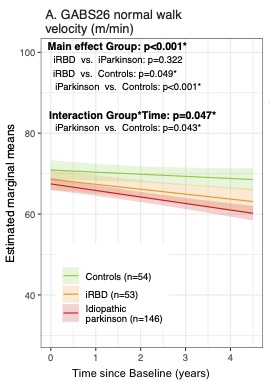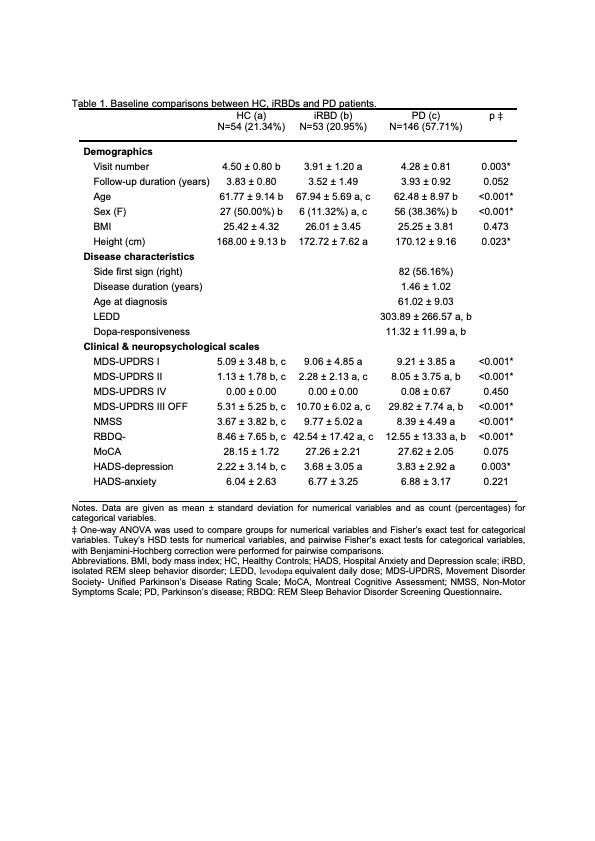Objective: We aimed at exploring gait speed (GS) as a potential biomarker of disease evolution in early stages of PD with three objectives. 1- To investigate whether GS evolution differs in patients at early stage of PD as compared to isolated REM-Sleep Behavior Disorders (iRBD) patients and healthy controls (HC). 2- To describe the characteristics of clinical and demographic factors associated to GS and its evolution in PD. 3- To measure the impact of dopaminergic medication on GS and its evolution in PD
Background: GS predicts fall risk in advanced phases of PD and it correlates to symptoms with low dopa responsiveness, representing a marker of poor prognosis for disease evolution. However, GS and its relation to motor and non-motor features, as well as its response to dopaminergic treatment, has not been deeply investigated in early and premotor phases of synucleinopathies.
Method: GS evolution was analyzed using the item 26 of the GABS scale (gait at preferred speed), collected annually within the ICEBERG cohort (ClinicalTrials.gov NCT02305147) over a 5-year follow-up period. PD patients underwent assessments in both OFF and ON states for the GABS and MDS-UPDRS. Linear mixed models were performed for each objective. For the first two objectives, GS of PD patients were analyzed in the OFF state.
Results: We included 146 PD patients, 53 patients with iRBDs and 54 age-matched HC (Table 1). At baseline, iRBD and PD patients walked slower than HC; over the 5-year follow-up, PD patients exhibited a faster decline in speed compared to HC (Figure 1). In PD patients, several factors were negatively associated with GS in the OFF state, including MDS-UPDRS II, III-OFF, IV, dopa responsiveness, BMI and age. Finally, GS was faster in the ON state compared to the OFF state (p<0.001), with no significant difference over time (p=0.936).
Conclusion: To our knowledge, this is the first longitudinal evaluation of GS in a large sample of early PD, iRBD and HC. We observed different trajectories in the three groups confirming that preferred GS as measured by item 26 of GABS scale is an early biomarker of synucleinopathies, since it can be decreased even at PD prodromal phases ( iRBD patients). Severity of motor parameters negatively affected GS, whereas non-motor features did not not seem to have an impact during early stages of PD. Finally, the impact of dopaminergic treatment on GS does not evolve with time in early phases.
Figure 1
Table 1
To cite this abstract in AMA style:
S. Sambin, M. Houot, F. Khoury, G. Mangone, L-L. Mariani, I. Arnulf, S. Lehericy, M. Vidailhet, J-C. Corvol. Longitudinal Gait Speed Analysis at Prodromal and Early Stage of Parkinson’s Disease [abstract]. Mov Disord. 2024; 39 (suppl 1). https://www.mdsabstracts.org/abstract/longitudinal-gait-speed-analysis-at-prodromal-and-early-stage-of-parkinsons-disease/. Accessed December 27, 2025.« Back to 2024 International Congress
MDS Abstracts - https://www.mdsabstracts.org/abstract/longitudinal-gait-speed-analysis-at-prodromal-and-early-stage-of-parkinsons-disease/


